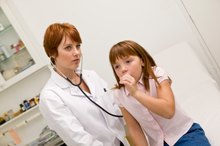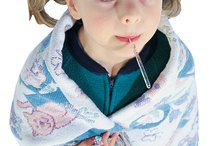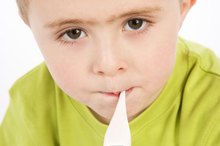104 Fever in a Toddler
A normal temperature for a toddler is 98.6 degrees or slightly higher. A fever of 104 degrees indicates a medical problem that should be evaluated by a physician. Rarely, a child with a fever of 104 degrees will have a seizure due to the increased temperature 3.
Causes
A toddler's fever of 104 degrees is often due to influenza. It may also be caused by a cold, an ear infection, meningitis, a urinary tract infection, infection in the bloodstream or some other condition. The child's physician can determine the exact cause of fever dependent on the child's other symptoms, a physical examination and laboratory tests.
- A toddler's fever of 104 degrees is often due to influenza.
- The child's physician can determine the exact cause of fever dependent on the child's other symptoms, a physical examination and laboratory tests.
Accompanying Symptoms
How Long Can a Fever Last With a Virus in a 10-Month-Old?
Learn More
A fever of 104 degrees in a toddler may be accompanied by a number of symptoms, depending on the fever's cause. Common symptoms include:
- a runny nose
- rapid breathing
- phlegm
- cough
- red cheeks
- vomiting
- diarrhea
Less common symptoms include
- ear pain
- confusion
- difficulty awakening
- a skin rash
- a stiff neck
- wheezing
- difficulty breathing
- little or no urine output
- a refusal to eat
Warning
A fever of 104 degrees should be evaluated by a physician, according to the American Academy of Family Physicians 2. The child's physician should be called or the child should be taken to the emergency room. The parent or caregiver should be prepared to tell the doctor when the fever was first noticed and any other symptoms that the child has exhibited. A list of medications that have been given and when they were given is also helpful. The physician may also want to know if the child has been exposed to a contagious disease in the last few weeks.
- A fever of 104 degrees should be evaluated by a physician, according to the American Academy of Family Physicians 2.
- The parent or caregiver should be prepared to tell the doctor when the fever was first noticed and any other symptoms that the child has exhibited.
Treatment
High Fever and a Loss of Appetite in Children
Learn More
The Palo Alto Medical Foundation indicates that acetaminophen or ibuprofen is typically used to treat fever in a toddler 1. It is important to carefully read the label or box in order to give the correct dosage. The medication should be in a dosage form appropriate for toddlers. Parents are sometimes instructed to give the child a lukewarm bath or to sponge the child's body with a lukewarm washcloth. The room should be kept a comfortable temperature and the child should wear light clothing. While the toddler's appetite may be diminished, fluids should be encouraged to avoid dehydration. The child will need more rest than usual as he recovers.
- The Palo Alto Medical Foundation indicates that acetaminophen or ibuprofen is typically used to treat fever in a toddler 1.
- While the toddler's appetite may be diminished, fluids should be encouraged to avoid dehydration.
Things to Avoid
Aspirin should not be given to a toddler without physician instruction, explains The Nemours Foundation. Rarely, it can cause a serious complication called Reyes syndrome. A child who is chilling should not be overbundled with multiple layers of clothing and blankets. A toddler should not be given a cold bath or rubbed with rubbing alcohol.
- Aspirin should not be given to a toddler without physician instruction, explains The Nemours Foundation.
- A child who is chilling should not be overbundled with multiple layers of clothing and blankets.
Related Articles
References
- Palo Alto Medical Foundation: Treating Fever
- American Academy of Family Physicians: Fever in Infants and Children
- KidsHealth: Fever and Taking Your Child's Temperature
- BabyCenter: Fever
- Gunduz S, Usak E, Koksal T, Canbal M. Why Fever Phobia Is Still Common? Iran Red Crescent Med J. 2016;18(8):e23827. doi:10.5812/ircmj.23827
- American Academy of Pediatrics. Fever and Your Baby. Updated August 3, 2016.
- Torreggiani S, Filocamo G, Esposito S. Recurrent Fever in Children. Int J Mol Sci. 2016;17(4):448. doi:10.3390/ijms17040448
- InformedHealth.org. Fever in Children: Overview. Cologne, Germany: Institute for Quality and Efficiency in Health Care (IQWiG); 2013.
- InformedHealth.org. Fever in children: When to see a doctor. Cologne, Germany: Institute for Quality and Efficiency in Health Care (IQWiG); 2009.
- MedlinePlus. When your baby or infant has a fever. Updated February 13, 2020.
- Lim T. Cleveland Clinic. Kids’ Fevers: When to Worry, When to Relax. Published May 12, 2015.
- Murren-Boezem J. The Nemours Foundation. Fevers. Updated September 2018.
Writer Bio
J. Lucy Boyd, RN, BSN has written several nonfiction books including "The Complete Guide to Healthy Cooking and Nutrition for College Students." She is frequently called upon to provide career guidance to medical professionals and advice to parents of children with challenges. She also loves teaching others to cook for their families.









